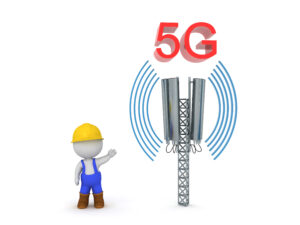Mastering the Pulse of 5G: Unravelling Synchronisation at the Transport Layer
The telecommunications industry is witnessing rapid advancements, particularly with the introduction of 5G technology. A key enabler of 5G’s high-speed, low-latency communication is synchronisation, which ensures that networks function smoothly. In this blog, the first of a three-part series, we will explore the critical role synchronisation plays in the transport layer of 5G networks.
The Role of 5G Synchronisation
Synchronisation is a fundamental requirement in 5G networks, essential for maintaining the performance, reliability, and consistent execution of services. Unlike previous generations, where synchronisation was a technical feature, in 5G it is a pillar that supports ultra-fast speeds and low latency, enabling applications like autonomous vehicles and the Internet of Things (IoT) (3GPP, 2020).
Key synchronisation methods, including the Global Navigation Satellite System (GNSS), Precision Time Protocol (PTP), and Synchronous Ethernet (SyncE), ensure that time-sensitive data packets travel across networks in harmony. Without precise synchronisation, 5G’s promise of ultra-reliable and low-latency communications would not be achievable (ITU-T, 2018).
Synchronisation Challenges in the Transport Layer
The transport layer in 5G networks serves as the backbone for data transmission. For 5G synchronisation, the Full Timing Support (FTS) protocol, as outlined in G.8275.1, plays a crucial role in maintaining timing accuracy, particularly for time-division duplexing (TDD) services (ITU-T, 2019). This ensures that data packets arrive at their destination in perfect sequence, vital for applications like virtual reality or autonomous driving.
particularly for time-division duplexing (TDD) services (ITU-T, 2019). This ensures that data packets arrive at their destination in perfect sequence, vital for applications like virtual reality or autonomous driving.
However, deploying synchronisation in 5G transport is not without its challenges. Urban environments, for example, pose significant difficulties due to signal blockages and reflections. In such settings, maintaining synchronisation often requires advanced planning and deployment strategies to overcome obstacles such as signal interference (IEEE, 2021). Another method, Partial Timing Support (PTS), as described in G.8275.2, is often used when full network timing isn’t feasible. In mixed-use networks that combine legacy and modern infrastructure, PTS offers flexibility while preventing signal interference and ensuring consistent service delivery (ITU-T, 2020). However, the challenge lies in maintaining synchronisation precision despite these network complexities.
Technologies Enabling 5G Synchronisation
 Key technologies such as GNSS, PTP, and SyncE form the foundation for maintaining synchronisation within 5G networks. GNSS provides universal timing via satellite, but its performance can be compromised in dense urban areas. This is where PTP and SyncE come into play.
Key technologies such as GNSS, PTP, and SyncE form the foundation for maintaining synchronisation within 5G networks. GNSS provides universal timing via satellite, but its performance can be compromised in dense urban areas. This is where PTP and SyncE come into play.
PTP, governed by standards such as G.8275.1 and G.8275.2, distributes time across packet networks, providing a flexible solution to GNSS limitations (IEEE, 2019). Meanwhile, SyncE ensures that frequency synchronisation occurs through the physical layer, which is essential for maintaining the integrity of 5G services (ITU-T, 2018). Together, these technologies enable the high-speed, low-latency requirements of 5G transport layers.
Testing 5G Synchronisation
Ensuring Precision Achieving precise synchronisation in 5G is not just about the deployment of appropriate technologies but also about ensuring their accuracy through rigorous testing. Tools such as the VIAVI T-BERD/MTS-5800 and OneAdvisor 800, enhanced with the Timing Expansion Module (TEM2), play a critical role in this process (VIAVI Solutions, 2023).
The TEM2 Timing Module provides nanosecond-accurate measurements, crucial for maintaining synchronisation in 5G networks. With a multi-band GNSS antenna and a Rubidium oscillator, these tools offer high precision even when GNSS signals are compromised. This is particularly important for maintaining network reliability during synchronisation holdover mode, allowing 5G networks to continue operating smoothly without GNSS signals (VIAVI Solutions, 2023).
Field engineers can use these tools to conduct comprehensive synchronisation testing based on profiles such as ITU G.8265.1, G.8275.1, and G.8275.2. This level of precision helps ensure that 5G networks meet the stringent standards necessary for real-time applications (ITU-T, 2021).
Synchronisation is more than a technical necessity for 5G, it is the backbone of its performance. With the complexity of modern networks, synchronisation at the transport layer becomes crucial for maintaining low-latency, high-speed communications. As 5G continues to evolve, ensuring synchronisation through advanced technologies and rigorous testing will be essential for the success of applications like autonomous driving and IoT. In the next article, we will explore the role of synchronisation at the radio layer, further uncovering how 5G is transforming the telecommunications landscape.
References:
3GPP. (2020). 5G System; Phase 1; Protocol Architecture.
IEEE. (2019). Standard for a Precision Clock Synchronisation Protocol for Networked Measurement and Control Systems.
ITU-T. (2018). Network Synchronisation Standards.
ITU-T. (2019). G.8275.1 – Precision Time Protocol Telecom Profile for Phase/Time Synchronisation.
ITU-T. (2020). G.8275.2 – Telecom Profile for Time Synchronisation in Partial Timing Support Networks.
ITU-T. (2021). Synchronisation in Next-Generation Networks.
VIAVI Solutions. (2023). VIAVI Solutions Technical Documentation on T-BERD/MTS-5800 and OneAdvisor 800.
